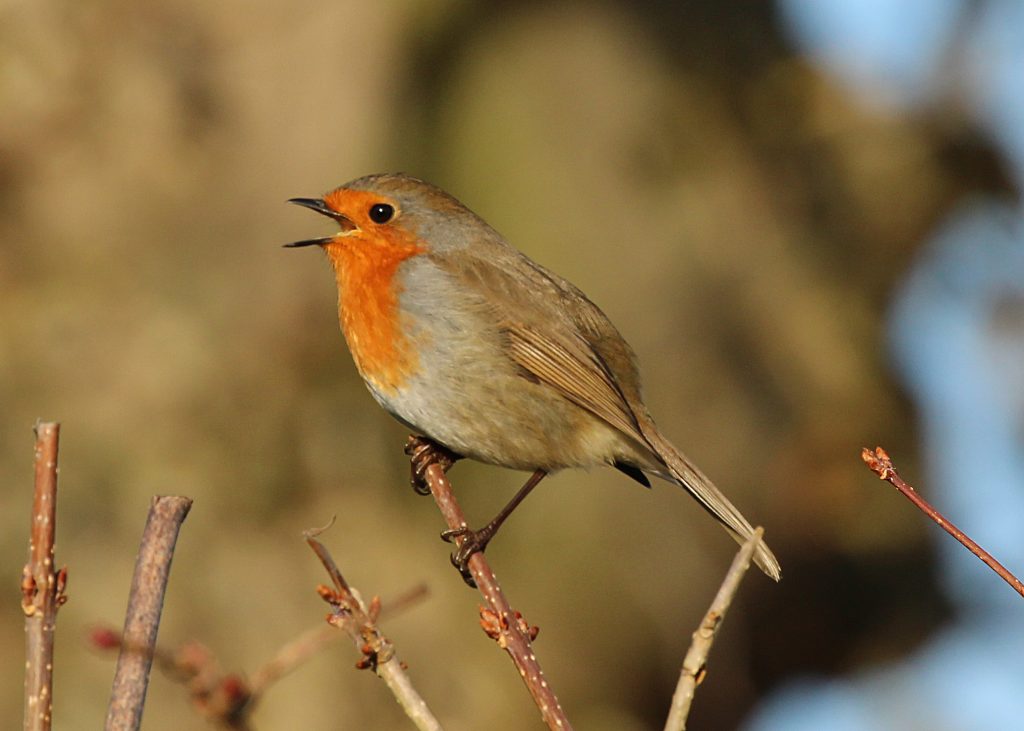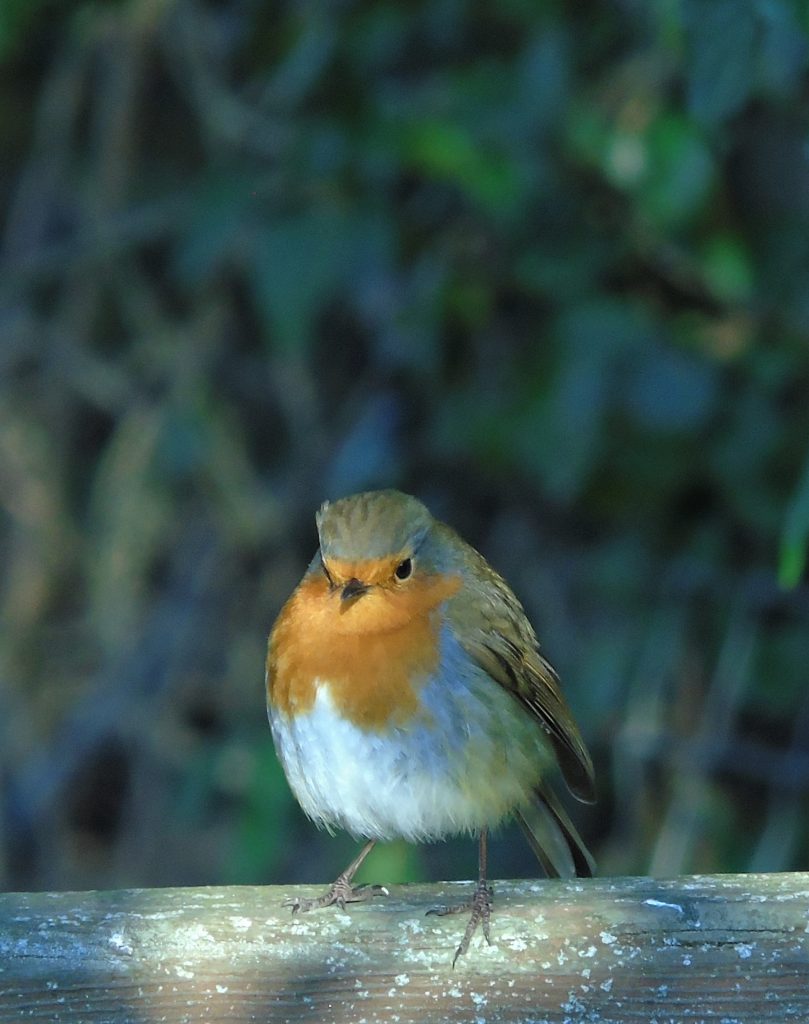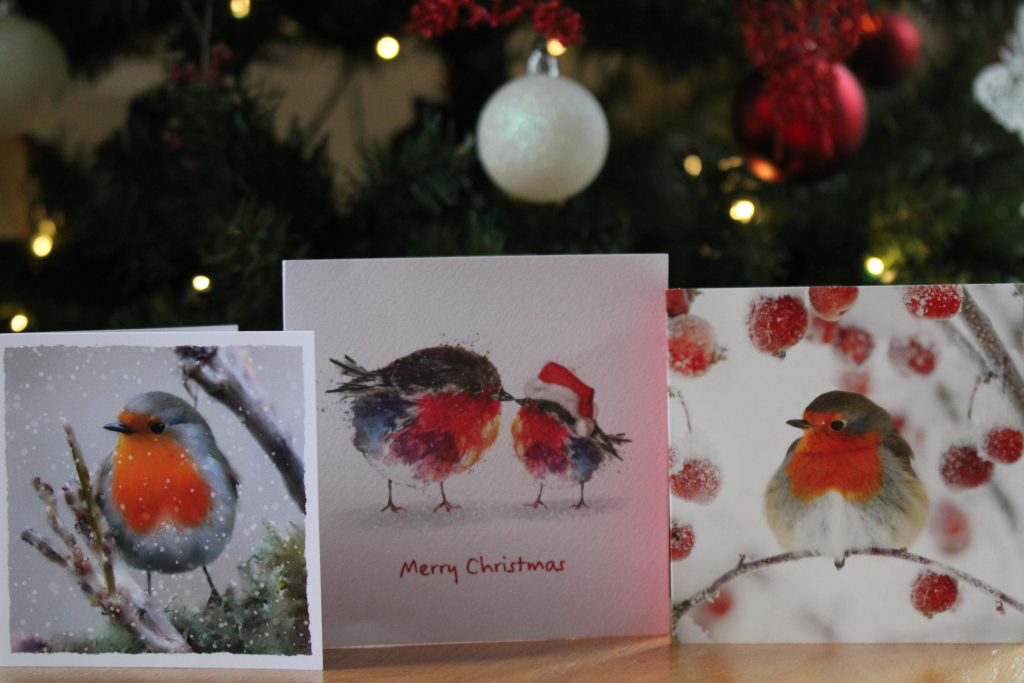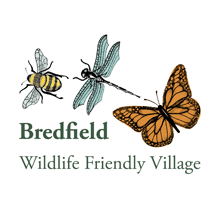It’s now official: the Robin is Britain’s number one favourite bird1. We love them the year round, but especially so at Christmas when envelopes of Robin-adorned Christmas cards arrive at our door. Let’s find out a bit more about Robins and why they’ve become so loved.

In Britain, Robins are known as approachable and confiding garden birds. The fact that they have adapted to living in British gardens is an important key: both to why they are cherished; and why they have thrived. Robins hold over 7.5 million territories in Britain and the population is rising. Many of these territories are in gardens. In this country, Robins are the quintessential, perch-on-a-fork-handle, garden bird. In other European countries, with migrant populations, Robins are more likely to be retiring woodland birds. British gardens, in the large, provide a good supply of food and opportunities for shelter. In rural areas, such as Bredfield, there is usually little to support Robins on surrounding arable farmland, and so they have moved into our gardens. If such gardens enhance their supply of food, with mealworms and sunflower seeds, Robins are living the dream!

Robins look cute and adorable, but they are highly aggressive to others of their kind. Don’t be fooled into thinking that the puffed-out red breast and year-round singing are all for the purposes of amorous courtship. Au contraire, they are being used to threaten and boast. “Clear off” is what the song of the male is saying to any other nearby male, “or I’ll have ya”! And ‘have ya’ might well be what it comes down to if the warning notes of its song don’t work. Physical aggression, with beaks and claws, can be a final, and sometimes fatal, last resort. The answer to the nursery rhyme question “who killed cock Robin?” is, most probably, another Robin.
Robins are now a set part of our culture and folk lore. Not surprising then that many poems are dedicated to them. In Auguries of Innocence2, William Blake declared that “Robin Redbreast in a cage, puts all heaven in a rage.” William Allingham3 (albeit, to some ears, in a rather cloying manner) saw Robins as a source of cheer in dark, cold and nature-depleted winters:
Good-bye, good-bye to Summer!
For Summer’s nearly done;
The garden smiling faintly,
Cool breezes in the sun;
Our Thrushes now are silent,
Our Swallows flown away,
But Robin’s here, in coat of brown,
With ruddy breast-knot gay.
Robin, Robin Redbreast,
O Robin dear!
Robin singing sweetly
In the falling of the year.
Before turning to something a little more ornithological, it is difficult to write about Robins and our culture without saying something about Christmas cards. How did Robins become associated with the traditions of Christmas? Though some have attempted to link our contemporary manners with the presence of a Robin at the nativity, it is most likely that the reason lies with the Post Office. According to Simon Moss4, the connection between Robins and Christmas “goes all the way back to 1840 and the launch of the ‘Penny Post’. To encourage people to use the new service, someone had the clever idea of producing special greeting cards that they could send to their friends and family. At the time, postmen wore red uniforms and were nicknamed ‘Robins’. It didn’t take long for an illustrator to design a card featuring a robin wearing a postman’s uniform and carrying a card in its beak. The rest, as they say, is history.”

OK, let’s turn to a few ornithological facts about Robins:
- Robins feed on insects (especially beetles), but will also eat berries and seeds, especially in winter.
- The average clutch size of Robins is 4-5 eggs, and they usually manage two (or perhaps three) broods per year. The first egg-laying will usually take place in late-April and incubation takes around 15 days.
- Robins usually make their nests in well-hidden places (such as within a bank of Ivy) about two metres from the ground. This said, they are a highly adaptive and creative species when it comes to nest-building, and there are lots of stories and social media photos of Robin’s nests turning up in the strangest of places (including on an unmade bed!).
- Young Robins do not attain their red breasts until the autumn of their first year. In the first months their breasts are spangled golden-brown.
- The average life span of a Robin is only about 13 moths, but this is due to a high mortality rate in their first year. Once they have survived into their second year, they can live much longer. It is claimed that the oldest Robin was recorded at 19 years!
The last question that remains to be answered is why Robins are so tame. Robins are largely ground feeders. If something or someone is disturbing the ground it becomes more likely that a beetle, or something else edible, will become exposed and can be eaten. Historically, animals such as Wild Boar would have been one of the main soil disturbers. Today, it is us. Robin’s associate humans with food opportunities – turning over soil or leaving out food – and hence it pays to keep in close proximity. They are not really being ‘friendly’ to us, we are being friendly to them. Let’s keep that up.
Notes:
- National Bird Campaign vote 2015.
- William Blake (1803) Auguries of Innocence
- William Allingham (1824) Robin Redbreast
- Simon Moss: The 13 birds of Christmas | BBC Wildlife Magazine | Discover Wildlife
All photographs taken in Bredfield.

